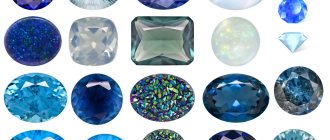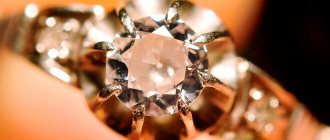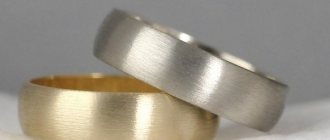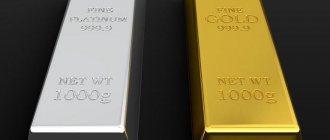Precious minerals, due to their splendor and radiant shine, have always attracted the eyes of people and become objects of admiration. However, what makes stones so expensive is not only their external beauty, but also their rarity. The cost of unique specimens reaches sky-high levels.
An equally important parameter for setting the price is the weight of the mineral. To measure the mass of precious stones, a non-standard unit is used - the carat, which is well known to jewelers. However, for an uninformed person, the weight of a carat in grams remains a mystery, so before buying expensive jewelry inlaid with diamonds or sapphires, you should know how much one carat weighs and how to determine the number of grams in a gem.
History of the emergence of jewelry measures
The mining and sale of precious stones dates back many centuries. In order to profitably sell gems, it was necessary to somehow determine their weight. The first weight standard was the grains of cereals that grew on a particular continent. The grains were selected in such a way that each grain was of the same weight and size.
The birthplace of most precious minerals was the countries of the Ancient East, where the standard of weight was considered to be the seeds of the carob tree - ceratonia. This plant was the ideal unit of measurement for the ancient Romans, since regardless of growth processes, each tree produced grains of identical size, weighing 189 mg each. The carob tree is considered the founder of the term “carat”.
Mediterranean countries used acacia seeds, which are relatively uniform in size and weight, to determine the weight of stones and gold. When Emperor Constantine ruled the Greeks, the country minted the solidus coin. The weight of this gold coin was equivalent to 24 acacia grains, which laid the basis for the emergence of the term “carat hallmark” as a definition of the purity of the metal.
It is also known that in European countries the weight of precious stones was determined using barley grains, which were the smallest of the cereals in the area. There is a version about a coral tree that grew in hot countries, the grains of which are almost equal to the weight of a carat. However, this position of the emergence of a jewelry unit of measure is the least likely.
Measurement systems of different countries
Until the beginning of the 20th century, there was no unified system for measuring the weight of precious stones. Each “point of sale” of expensive minerals around the world used its own measure. Because of this, confusion arose when trying to determine the value of the gem, because the difference in weight sometimes reached 0.026 grams, which is quite significant. In Russia, since 1922, it has been generally accepted that 1 carat is 200 mg or 0.2 g.
Metric carat
In 1907, in Paris, the IV General Conference on Weights and Measures adopted the official weight measure for precious minerals and pearls - the carat, which was equivalent to 0.2 grams or 200 mg. The metric carat quickly became the standard jewelry measure for most countries.
English carat
In England, the local measure for the weight of gems was 205.4 mg. The entire weight system of the country, including jewelry, was based on the troy pound, the main English unit. This unit in turn was divided into several others, ultimately resulting in a troy grain equal to 64.79 mg. A carat was equal to 3.17 troy grains until 1888. Afterwards, the Ministry of Commerce determined the weight of the English measure as 205.3 mg. Since 1914, England has used the world metric system.
Also read: 15 Most Popular Purple Minerals
Arabic carat
The canonical karat or qirat was used throughout Iraq. There, the jewelry unit of measurement was equal to 1/14 of the weight of the local silver coin - the dirham, which is proportional to 223.2 mg. The Kirat of Syria, Egypt and Mecca differed significantly in weight, answering 195 mg. At the same time, the Egyptian qirat was put in relation to its own measures of weight - bakila and shamuna. The Kyrat of Asia Minor was also different, equaling 204 mg.
Alternative weights
In addition to the generally accepted carat weight system, jewelers use the following terms:
- Jewelry gran is a unit equal to ¼ carat or 50 mg. Today it is no longer used. Previously, the weight of pearls was determined using grains.
- Gram is a unit used in purchase and sale transactions of raw materials. In jewelry making, it is important to know how many grams are contained in one carat in order to estimate the approximate weight of the stone that can be obtained from this raw material.
- Momme is a measure of weight that is used only by the Japanese to measure the mass of pearls. Momme is 18.75 carats.
The carat of a stone is one of the main criteria for assessing the value of a precious mineral. Therefore, to set the price of a gem, measurements are carried out with maximum accuracy. In abbreviated form, the carat value of a stone is denoted “ct”.
Calculation of gem weight relative to cut
How can one calculate how many grams a particular sample weighs, relative to the method of cutting it? Here are three effective formulas:
- Round diamond. The mass of the sample in this case will be equal to the diameter of the girdle squared multiplied by the height of the crystal and multiplied by a factor of 0.0061. Why isn’t it calculated using the usual ball formula? The fact is that the stone does not have an ideal round shape, but fifty-seven faces, which is why we multiply by a coefficient. For stones with one hundred and two sides, the coefficient will be slightly different.
- Diamond "Princess". Here the weight of the sample can be found using the following formula: the height of the pebble, multiplied by the width and length, and multiplied by a factor of 0.0083. As you can see, this type of cutting preserves more material, so this type of cutting is more profitable.
- Oval cut. Here the calculation is similar to that for round cutting. The height of the mineral must be multiplied by the diameter squared and by a factor of 0.0062. Not to say that cutting is very economical, but still more material is saved than with a round cut.
So, 1 carat is approximately equal to 200 mg.
Carat price of gemstones
Today, precious stones and jewelry with them are considered not only an attribute of secular society, but also a profitable financial investment. Some minerals reach values of tens and hundreds of thousands of dollars. Diamonds remain at the price peak, although some rare minerals are confidently ahead of diamonds in this struggle for leadership.
Top five gems
Despite the large number of scientific classifications of minerals, based on various characteristics, there is still no clear division of stones. After all, sometimes a flawless rare gem is several times higher than the cost of a diamond of poor quality. However, a conventional five precious minerals have been identified that top the list of the most expensive stones:
- Diamond. The cost of 1 carat of diamond starts at 15 thousand dollars, determined by a number of criteria. But there are also so-called “folk” diamonds - stones of 0.1 ct that cost about 10,000 rubles. Carbonado, a black diamond with an average price of $150/ct, is considered inexpensive. The best stones reach 500-600 $/ct.
- Emerald. Estimated from $350/ct. This refers to the lowest quality stones. An emerald with ideal characteristics starts at $8,500/ct, increasing in price in proportion to the size of the nugget - a top-quality cut emerald weighing 5 carats or more costs about $15,000/ct.
- Ruby. Low quality red corundums sell for $100/ct. But if a red nugget is assessed as flawless, then the price per carat of such a stone soars to 15 thousand.
- Sapphire. The most expensive is cornflower blue corundum. The heated mineral sells from 300 to 1000 $/ct. A mineral that cannot be heat treated starts at $1000/ct. The orange Padparadscha sapphire is considered a rare gem. Its price starts from 130 $/ct. A collectible piece weighing 5 carats or more can cost about $30 thousand.
- Alexandrite. A stone weighing 3-5 carats of lower quality sells for 600-2500 dollars. The best specimens cost up to $22,000/ct. The record price for a carat of Russian alexandrite sold at auction was $70,000.
Also read: Stone of Ra - Place of Power in the Moscow region
The five stones that top the lists of the most expensive minerals in the world are not the last selection of beautiful gems that belong to the category of precious stones.
Video about the cost of 1 carat of diamond:
Diamond quality rating:
Popular precious minerals
The list of fascinating stones can be continued indefinitely, but the highest positions are occupied by:
- Tanzanite – average price – $500 per carat. The best samples reach $1000/ct.
- Topaz is the most valuable untreated imperial stone of a yellow hue, estimated at 70-500 $/ct, pink - from 500 to 3500 $/ct.
- Sultanite – green palette – 100-150 $/ct. Complex color combinations are twice as expensive.
- Demantoid – 200-300 $/ct. Large specimens reach $1000 per carat.
- Corundum - depending on the variety and quality - from $50-100 to several tens of thousands per carat.
- Noble spinel – the price starts from 20-30 $/ct, reaching 1000 $/ct for rare specimens.
- Amethyst – from 20 to 100 $/ct.
- Rauchtopaz (smoky quartz) – 900-8000 rubles per stone.
- Garnet – from 600 to 2000 rubles per carat.
Artificial cubic zirconias are very popular - they shine en masse in jewelry, successfully copying diamonds. But their cost is cheap - 10-15 dollars for a bag of 100 pieces of medium-sized stones, 50 dollars for a similar volume of multi-colored raw materials.
Round Diamonds – How to Divide them
Round diamonds are grouped according to the quality of their finish. These can be group stones:
- A – flawless specimens;
- B – high rating;
- B – rating “good”;
- G – means “satisfactory”.
The large solitaire with a high level of finishing shines especially brightly. In turn, small diamonds play with light almost imperceptibly. Round solitaires, unlike square and fancy-shaped stones, in addition to powerful brilliants, have sparkle, for which they are valued higher. Such solitaires attract attention, shimmering with all the colors of the rainbow and emitting an inner glow.
The relationship between the weight and size of the stone
There is a misconception that the weight of a gemstone characterizes its size. But the physical and chemical nature of minerals is designed in such a way that different gems of the same weight have different sizes due to different densities. Compared to a diamond, a one-carat sapphire or ruby will be smaller in size, but an emerald will be larger.
Another indicator that determines the size of a stone is its cut. According to this criterion, even diamonds of the same weight differ in size.
These sizes are indicated for cut group A. For other cut groups, sizes may vary slightly.
So, a one-carat diamond will have completely different sizes, depending on the cut:
- Circle. The most popular cut shape. The diameter of this stone is 6.5 mm. Round diamonds, regardless of the number of facets, are the most expensive, since the lion's share of the precious weight is lost during processing.
- "Marquis". A cut that was born thanks to the favorite of the King of France. The diamond, reminiscent of the smile of the Marquise de Pompadour, measures 9.8 * 5.6 mm.
- Square. This shape implies different types of cuts, the most popular of which are “Princess” and “Asscher”. Size – 5.55*5.55 mm.
- Oval. Size – 7.7*5.9 mm. The brilliance of oval diamonds is identical to that of round stones, but the former benefit from their size.
- "Cushion" and "Radiant". Square cut with beveled edges, stone size 6*5.5 mm.
- "Pear". This shape is a tandem of two other shapes – circle and “Marquise”. Size – 8.6*5.8.
- Heart. A cut designed to hide the natural imperfections of a diamond, measuring 6.7*6.5 mm.
- "Baguette". A one-carat stone has a size of 7.7 * 4.5 mm. The brilliance of a piece of this shape outshines the brilliance of round diamonds.
- Emerald. Size – 6.4*4.9 mm. This type of cut is only suitable for flawless stones. Otherwise, this form will highlight all the shortcomings. Emerald shapes shine brighter than round ones, but the latter better convey the play of color.
Also read: Jewelry with Jasper
Stone sizes
If we talk about the weight of diamonds, then the carat plays a decisive role only in the evaluation of small stones. When determining the cost of large specimens, first of all, they take into account the indicators of purity and color.
Stone purity table
Diamond Color Chart
What should you pay attention to?
Purchasing high purity karat gold will be the smartest investment. If necessary, you can sell the ring or chain at a higher price, since the price of gold has not fallen for many years.
On the other hand, for those who value primarily the aesthetic component, without intending to invest money in jewelry, numerous alloys may be suitable. The use of non-ferrous metal will allow you to create uniquely beautiful floral or fantasy compositions.
The strength of the alloys will allow you to make the finest cuts of the product and decorate it with filigree carvings. The combination of rose or green gold with a similar gemstone shade looks very beautiful. In any case, when purchasing an item from a jeweler, find out about the content of precious metals, the quality of the stones, the percentage of pure gold content, and the components of the alloy. This way you will be sure that you did not make a mistake with your purchase.
Carat of precious metals
The term "carat" is also used to define the purity of precious metals or the amount of precious metal in an alloy. The hallmark carat is designated by the letter "K" or "kt".
Today, countries such as the USA and Canada use the karat system. The pure metal alloy has a purity of 24 carats. Depending on the proportion of noble metal content in the alloy, samples are distinguished:
- 23K - the mass of the noble metal is 0.958 of the weight of the alloy.
- 22K – 0.916.
- 21K – 0.875.
- 18K – 0.750.
- 14K – 0.583.
- 12K – 0.500.
- 9K – 0.375.
Correspondence of metric and carat assay systems
In the countries of the former Soviet Union, since 1927, the metric system of measures has been used, which determines the assay of various alloys by the ratio of the amount of noble metal in 1 mg of the alloy. Various hallmarks are defined for platinum, gold, silver and palladium. The karat standard is easily converted to the metric system with two simple mathematical steps. To do this, the carat value is divided by 24 and multiplied by 1000.
The metric testing system is used by dozens of countries in Europe and the world. Ireland uses both hallmarks on the product mark. England puts a metric measure on the stamp, but the description of the product (exclusively made of gold) also allows for a karat standard.
Ounce
For trading on the stock exchange, the troy ounce is used, which is a fairly accurate measurement. It should not be confused with those previously described. A troy ounce corresponds only to pure gold, with a purity level of 999 or higher. It indicates the weight of the metal, and in accordance with this helps to find out its price on the world market. By weight it is approximately 31.103 grams. If you purchase investment coins, bars, or a virtual amount of gold through a bank or exchange, you will encounter exactly this value, which is designated as ozt.
Note
In addition to the carat, jewelers use another unit of measurement – the point. So, 1 carat is equal to 100 points. The weight of the stone is measured with an accuracy of 1 point, which is equal to 1/100 of a carat. It is believed that this unit of measurement was invented in order to bypass the standard metric system. After all, when it comes to diamonds, stones weighing 200 mg or 1 carat are rare, found only once among 250 tons of processed diamond ore.
When buying a diamond, you should know that it is impossible to visually distinguish a stone weighing 0.96 carats from a specimen weighing 1.02 carats. But the price of the former will be half that of the latter.
5/5 — (3 votes)










